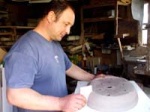Glazing or re-glazing new or old pots
+4
Stone Monkey
Klaudia & Martin
Gwyther
Todd Ellis
8 posters
Page 1 of 1
 Glazing or re-glazing new or old pots
Glazing or re-glazing new or old pots
I am re-posting this for mre responses:
I have some Chinese pots which I bought because the price was right. I keep thinking that they could be enhanced with nicer glazes. The current glazes are not glossy, but look "painted"; the yellow and reddish brown glazing. A bit garish for the trees I have in mind; but the pot shapes are nice. Can pots, glazed or unglazed, be glazed or reglazed again?
I presume they would have to be cleaned and dried out.
Thank you for your help.
Salut,
Todd
I have some Chinese pots which I bought because the price was right. I keep thinking that they could be enhanced with nicer glazes. The current glazes are not glossy, but look "painted"; the yellow and reddish brown glazing. A bit garish for the trees I have in mind; but the pot shapes are nice. Can pots, glazed or unglazed, be glazed or reglazed again?
I presume they would have to be cleaned and dried out.
Thank you for your help.
Salut,
Todd

Todd Ellis- Member
 Re: Glazing or re-glazing new or old pots
Re: Glazing or re-glazing new or old pots
Hi Todd
Personally i would not advise doing this. There are too many variables that can have negative effects on the out come, especially if the pots are already glazed. At best the results will be unpredictable and at worst the pots could be lost and the kiln shelves damaged and kiln shelves are very expensive!
Cheers
Vic
Personally i would not advise doing this. There are too many variables that can have negative effects on the out come, especially if the pots are already glazed. At best the results will be unpredictable and at worst the pots could be lost and the kiln shelves damaged and kiln shelves are very expensive!
Cheers
Vic

Gwyther- Member
 Re: Glazing or re-glazing new or old pots
Re: Glazing or re-glazing new or old pots
Hello Todd
What about some sandblasting or a strong acid to improve the glaze?
Kind regards
Martin
What about some sandblasting or a strong acid to improve the glaze?
Kind regards
Martin

Klaudia & Martin- Member
 Re: Glazing or re-glazing new or old pots
Re: Glazing or re-glazing new or old pots
Todd
I am with Vic, too much risk with right temp and what glazed used. Unless you have some spare kiln shelves going or have the glaze info on the pot you wish to re-glaze then I would pass on it mate
All the best
Andy
I am with Vic, too much risk with right temp and what glazed used. Unless you have some spare kiln shelves going or have the glaze info on the pot you wish to re-glaze then I would pass on it mate
All the best
Andy

Stone Monkey- Member
 Re: Glazing or re-glazing new or old pots
Re: Glazing or re-glazing new or old pots
Thank you for your suggestions and cautions. How about adding glaze to unglazed pots? Could this be done with minimal risk?
thanks,
Todd
thanks,
Todd

Todd Ellis- Member
 Re: Glazing or re-glazing new or old pots
Re: Glazing or re-glazing new or old pots
Hi Todd, probably the biggest "problem" is not knowing the clays maturation temp and absorption %. I've re-fired some "New" Korean pots with low-fire speciality glazes with no problems BUT, BUT, BUT did I say but. These were new and were heated to 200f for 6 hours before firing. Fired stoneware, even to maturity has a small absorption rate and if it's been exposed to water there will be absorbed water. A very small amount but in dense fired stoneware that absorbed water doesn't have the escape capacity before turning into STEAM. Trapped steam is an explosion waiting to happen. It sounds as if you are not experienced so if I were you I would reconsider. Just my thoughts.
Wood
Wood
GaryWood- Member
 Re: Glazing or re-glazing new or old pots
Re: Glazing or re-glazing new or old pots
Hi, I am not really experienced with firing ceramics. I suspected that moisture would be a problem, and since stoneware is porous, I wondered if water woudl be trapped. I think my best bet to change the existing glaze is to sand blast or use stong acid. Or, just leave them as is and hope they age ... faster than I do  .
.
Thanks everyone for your thoughts! I feel very glad to be part of this world-wide community!
Salut, Todd
Thanks everyone for your thoughts! I feel very glad to be part of this world-wide community!
Salut, Todd

Todd Ellis- Member
 Re: Glazing or re-glazing new or old pots
Re: Glazing or re-glazing new or old pots
I'm pretty much an amateur, but the comments above fall in line with my gut sense. In addition to the risks already listed, we had a demo at the community college a few weeks ago by a guy who sometimes does his firing "backwards." He will go directly to a high fire to full maturity without doing a bisque fire, giving his large sculptural pieces strength. He then glazes and fires at lower temperatures, sometimes multiple times, working his way down in temperature. One of the points he brought up was that glazes that work on bisque ware may not work on a piece fired to maturity, they have to be reformulated, largely adding gums to improve adhesion. My biggest fear would be the piece might be a lower fire clay that will turn into a Salvatore Dali mess, wrecking not only it, but the kiln shelf and stuff around it.

(Needless to say, the student who made the bowl engulfed in that was not too pleased!)
I had a thought that maybe putting a pot through a wood firing with no additional glaze might provoke some interesting aging and "rustic-izing" but wood firing is generally pretty high temperature too, so there's still the meltdown hazard.

(Needless to say, the student who made the bowl engulfed in that was not too pleased!)
I had a thought that maybe putting a pot through a wood firing with no additional glaze might provoke some interesting aging and "rustic-izing" but wood firing is generally pretty high temperature too, so there's still the meltdown hazard.

DWThomas- Member
 Re: Glazing or re-glazing new or old pots
Re: Glazing or re-glazing new or old pots
Thanks DW. I appreciate the comments and a wood fire might add some interesting features to the pot.
Best, Todd
Best, Todd

Todd Ellis- Member
 Re: Glazing or re-glazing new or old pots
Re: Glazing or re-glazing new or old pots
hi
I second what Gary woods said.
having said this, I don't know anything about ceramics and pottery. I did re-glase a pot some years ago, though. I'm afraid this happend before the digital cam age, sorry no pics. However, in all my ignorance I took a grey stoneware pot and re-glased it, first by greasing the glase in olive oil - and only the glasing, then I dusted the olive oil with potash to make the new glasing stick, then dipped the lot (only the glasing) upside down. I let it dry for a few hours, then I put in the kiln and fired the pot at 1100' celsius. The glasing turned out a lot different than I intendet, but to the better effect. The glasing ended up having teardrops, cracks and a very aged look. The original pale blue-green glasing fused (I guess) with the brown glasing and gave the pot the look of aged/oxidated cobber. However, the pot had some tension build in (for lack of better words - it had a new higher sound). Perhaps this pot would crack during hard winter times, but I never used it for outdoor bonsai anyways. I guess I had a fools luck with this experiment...since it didn't explode.
I second what Gary woods said.
having said this, I don't know anything about ceramics and pottery. I did re-glase a pot some years ago, though. I'm afraid this happend before the digital cam age, sorry no pics. However, in all my ignorance I took a grey stoneware pot and re-glased it, first by greasing the glase in olive oil - and only the glasing, then I dusted the olive oil with potash to make the new glasing stick, then dipped the lot (only the glasing) upside down. I let it dry for a few hours, then I put in the kiln and fired the pot at 1100' celsius. The glasing turned out a lot different than I intendet, but to the better effect. The glasing ended up having teardrops, cracks and a very aged look. The original pale blue-green glasing fused (I guess) with the brown glasing and gave the pot the look of aged/oxidated cobber. However, the pot had some tension build in (for lack of better words - it had a new higher sound). Perhaps this pot would crack during hard winter times, but I never used it for outdoor bonsai anyways. I guess I had a fools luck with this experiment...since it didn't explode.

Loke Emil- Member
 Re: Glazing or re-glazing new or old pots
Re: Glazing or re-glazing new or old pots
Gary nailed it. Ill just add, that I have had great success refiring chinese bonsai pots (many with caligraphy) using cone 05 low stone amaco glazes. But mostly on unglazed pots. A friend got a great deal but many were somewhat gaudy, so we "fixed" them. As a low temp glaze most of the boating and crazing problems are overcome. The beauty of these glazes is it really has the look and feel of high fired stoneware glazes, and covers and adheres well, I use a sprayer and give three light coats. Another nice thing is they can run along with a load of bisque.GaryWood wrote:Hi Todd, probably the biggest "problem" is not knowing the clays maturation temp and absorption %. I've re-fired some "New" Korean pots with low-fire speciality glazes with no problems BUT, BUT, BUT did I say but. These were new and were heated to 200f for 6 hours before firing. Fired stoneware, even to maturity has a small absorption rate and if it's been exposed to water there will be absorbed water. A very small amount but in dense fired stoneware that absorbed water doesn't have the escape capacity before turning into STEAM. Trapped steam is an explosion waiting to happen. It sounds as if you are not experienced so if I were you I would reconsider. Just my thoughts.
Wood
Just remember to give it a overnight candling, as I have first hand experience at the mess one blown pot can make. uug
Good luck
glaze link...http://www.amaco.com/shop/product-220-stone-texture-st-low-fire-cone-05-glazes-for-bisque-lead-free.html

rock- Member
 Similar topics
Similar topics» experience , group new works
» Glazes & Glazing
» A Trip Down Memory Lane - Pots from My Past
» New Spring Pots
» Shell 2010
» Glazes & Glazing
» A Trip Down Memory Lane - Pots from My Past
» New Spring Pots
» Shell 2010
Page 1 of 1
Permissions in this forum:
You cannot reply to topics in this forum






